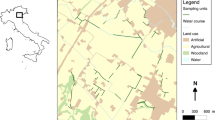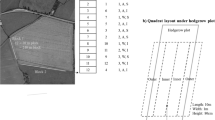Abstract
Many herbaceous forest plant species are endangered and suffer from habitat loss and fragmentation, especially in agricultural landscapes. Hedgerow networks represent a forested habitat that may serve as a refuge for forest herbs, even though also hedges have recently been strongly reduced in number and size. It is yet disputed to which extent hedgerows offer a suitable environment for forest herbs and which environmental factors may affect the frequency of these species in hedgerows. To develop an effective conservation strategy for forest herbs in hedgerows on a larger spatial scale, we aimed to combine a set of ecological and life history traits for predicting the frequency of these species in a local data set. A literature data set was used to examine the regional differences in the species composition of forest herbs and environmental conditions in hedgerows along a climate gradient across north-western Europe. Contrary to our expectations, the chosen set of variables in combination had a lower ability of predicting the local frequency of forest herbs in hedgerows than the single variable light availability. An ordination of species lists in the literature data set showed pronounced regional differences in the species pools of forest herbs in hedgerows, the floristic gradient being closely related to climatic continentality. Hedgerows in more continental regions had lower proportions of chamaephytes and, according to an indicator species analysis, drier and less acid soils.

Similar content being viewed by others
References
Agger P, Brandt J (1988) Dynamics of small biotopes in Danish agricultural landscapes. Landsc Ecol 1:227–240
Andrews M, Mercer C, Griffin P, Andrews ME, Cherrill A (1999) Autecology of common herbaceous hedgerow species in Britain. Asp Appl Biol 54:353–360
Bailey SA (2007) Increasing connectivity in fragmented landscapes: an investigation of evidence for biodiversity gain in woodlands. For Ecol Manage 238:7–23
Barnes G, Williamson T (2006) Hedgerow history: ecology history and landscape character. Windgather Press, Bollington, UK
Barr CJ, Gillespie MK (2000) Estimating hedgerow length and pattern characteristics in Great Britain using Countryside Survey data. J Environ Manage 60:23–32
Bates GH (1937) The vegetation of wayside and hedgerow. J Ecol 25:469–481
Baudry J (1988) Hedgerows and hedgerow networks as wildlife habitats in agricultural landscapes. In: Park JR (ed) Environmental management in agriculture—European perspectives. Belhaven Press, London, UK, pp 111–124
Baudry J, Bunce RGH, Burel F (2000) Hedgerows: an international perspective on their origin, function and management. J Environ Manage 60:7–22
Boutin C, Jobin B, Bélanger L, Choiniére L (2002) Plant diversity in three types of hedgerows adjacent to cropfields. Biodivers Conserv 11:1–25
Burel F (1996) Hedgerows and their role in agricultural landscapes. Crit Rev Plant Sci 15:169–190
Burel F, Baudry J (1990) Structural dynamic of a hedgerow network landscape in Brittany France. Landsc Ecol 4:197–210
Burel F, Baudry J (1995) Species biodiversity in changing agricultural landscapes: a case study in Pays d’Auge, France. Agric Ecosyst Environ 55:193–200
Cherrill A, Mercer C, McClean C, Tudor G (2001) Assessing the floristic diversity of hedge networks: a landscape perspective. Landsc Res 26:55–64
Chincarini M, Padoa-Schioppa E (2001) The ecological evaluation of hedgerows: a first attempt at a practical approach. In: Barr CJ, Petit S (eds) Hedgerows of the world: their ecological functions in different landscapes. IALE, Birmingham, UK, pp 81–92
Conrad V (1946) Methods in climatology. Harvard University Press, Cambridge, USA
Corbit M, Marks PL, Gardescu S (1999) Hedgerows as habitat corridors for forest herbs in central New York, USA. J Ecol 87:220–232
Cummins RP, French DD (1994) Floristic diversity, management and associated land use in British hedgerows. In: Watt TA, Buckley P (eds) Hedgerow management and nature conservation. Wye College Press, Ashford, UK, pp 95–106
Cunningham SA (2000) Effects of habitat fragmentation on the reproductive ecology of four plant species in mallee woodland. Conserv Biol 14:758–768
De Keersmaeker L, Martens L, Verheyen K, Hermy M, De Schrijver A, Lust N (2004) Impact of soil fertility and insolation on diversity of herbaceous woodland species colonizing afforestations in Muizen forest (Belgium). For Ecol Manage 188:291–304
Deckers B, Hermy M, Muys B (2004a) Factors affecting plant species composition of hedgerows: relative importance and hierarchy. Acta Oecol 26:23–37
Deckers B, Verheyen K, Hermy M, Muys B (2004b) Differential environmental response of plant functional types in hedgerow habitats. Basic Appl Ecol 5:551–566
Deckers B, De Becker P, Honnay O, Hermy M, Muys B (2005a) Sunken roads as habitats for forest plant species in a dynamic agricultural landscape: effects of age and isolation. J Biogeogr 32:99–109
Deckers B, Kerselaers E, Gulinck H, Muys B, Hermy M (2005b) Long-term spatio-temporal dynamics of a hedgerow network landscape in Flanders, Belgium. Environ Conserv 32:20–29
Dzwonko Z, Loster S (1989) Distribution of vascular plant species in small woodlands on the western Carpathian foothills. Oikos 56:77–86
Ellenberg H (1996) Vegetation Mitteleuropas mit den Alpen. Ulmer, Stuttgart, Germany
Ellenberg H, Weber HE, Düll R, Wirth V, Werner W, Paulißen D (1992) Zeigerwerte von Pflanzen in Mitteleuropa. Scr Geobot 18:1–258
Forman RTT (1995) Land mosaics: the ecology of landscapes and regions. University Press, Cambridge, USA
Forman RTT, Baudry J (1984) Hedgerows and hedgerow networks in landscape ecology. Environ Manage 8:495–510
Freemark KE, Boutin C, Keddy CJ (2002) Importance of farmland habitats for conservation of plant species. Conserv Biol 16:399–412
French DD, Cummins RP (2001) Classification, composition, richness and diversity of British hedgerows. Appl Veg Sci 4:213–228
Fritz R, Merriam G (1996) Fencerow and forest edge architecture in eastern Ontario farmland. Agric Ecosyst Environ 59:159–170
Helliwell DR (1975) The distribution of woodland plant species in some Shropshire hedgerows. Biol Conserv 7:61–72
Hermy M, Honnay O, Firbank L, Grashof-Bokdam C, Lawesson JE (1999) An ecological comparison between ancient and other forest plant species of Europe, and the implications for forest conservation. Biol Conserv 91:9–22
Honnay O, Hermy M, Coppin P (1999) Effects of area, age and diversity of forest patches in Belgium on plant species richness, and implications for conservation and reforestation. Biol Conserv 87:73–84
Honnay O, Verheyen K, Butaye J, Jacquemyn H, Bossuyt B, Hermy M (2002) Possible effects of habitat fragmentation and climate change on the range of forest plant species. Ecol Lett 5:525–530
Klotz S, Kühn I, Durka W (2002) Eine Datenbank mit biologisch-ökologischen Merkmalen zur Flora von Deutschland. Schriftenreihe für Vegetationskunde 38:1–334
Lauer W, Bendix J (2004) Klimatologie. Westermann, Braunschweig, Germany
Le Cœur D, Baudry J, Burel F (1997) Field margins plant assemblages: variation partitioning between local and landscape factors. Landsc Urb Plan 37:57–71
Le Cœur D, Baudry J, Burel F, Thenail C (2002) Why and how we should study field boundary biodiversity in an agrarian landscape context. Agric Ecosyst Environ 89:23–40
MacDonald DW, Johnson P (2000) Farmers and the custody of the countryside: trends in loss and conservation of non-productive habitats. Biol Conserv 94:221–234
McCollin D, Jackson JI, Bunce RGH, Barr CJ, Stuart R (2000) Hedgerows as habitat for woodland plants. J Environ Manage 60:77–90
Peterken GF (1974) A method for assessing woodland flora for conservation using indicator species. Biol Conserv 6:239–245
Petit S, Stuart R, Gillespie MK, Barr CJ (2003) Field boundaries in Great Britain: stock and change between 1984, 1990 and 1998. J Environ Manage 67:229–238
Pollard E (1973) Hedges: VII. Woodland relic hedges in Huntington and Peterborough. J Ecol 61:343–352
Pollard E, Hooper MD, Moore NW (1974) Hedges. William Collins Sons & Co Ltd, London, UK
Reif A, Schulze ED, Zahner K (1982) Der Einfluß des geologischen Untergrundes, der Hangneigung, der Feldgröße und der Flurbereinigung auf die Heckendichte in Oberfranken. Berichte der ANL 6:231–253
Rounsevell MDA, Annetts JE, Audsley E, Mayr T, Reginster I (2003) Modelling the spatial distribution of agricultural land use at the regional scale. Agric Ecosyst Environ 95:465–479
Roy V, de Blois S (2006) Using functional traits to assess the role of hedgerow corridors as environmental filters for forest herbs. Biol Conserv 130:592–603
Schmidt M, von Oheimb G, Kriebitzsch WU, Ellenberg H (2002) Liste der im norddeutschen Tiefland typischen Waldgefäßpflanzen. Mitt Bundesforsch Forst- und Holzwirtschaft 206:1–37
Schmucki R, de Blois S (2009) Population structure and individual performances of Trillium grandiflorum in hedgerows and forest habitats. Plant Ecol 202:67–78
Sitzia T (2007) Hedgerows as corridors for woodland plants: a test on the Po Plain, northern Italy. Plant Ecol 188:235–252
Smart SM, Bunce RGH, Stuart RC (2001) An assessment of the potential of British hedges to act as corridors and refuges for Ancient Woodland Indicator plants. In: Barr CJ, Petit S (eds) Hedgerows of the world: their ecological functions in different landscapes. IALE, Birmingham, UK, pp 137–146
Sparks TH, Meek WR, Mountford JO, Pywell RF (2000) The spatial distribution of herbs and woody species in the hedgerows of an arable farm. Asp Appl Biol 58:401–406
Stoate C, Boatman N, Borralho RJ, Carvalho CR, De Snoo GR, Eden P (2001) Ecological impacts of arable intensification in Europe. J Environ Manage 63:337–365
Sumner ME (ed) (2000) Handbook of soil science. CRC Press, Boca Raton, USA
Tack G, van der Bremt P, Hermy M (1993) Flanders forests: a historical ecology. Davidsfonds, Leuven, Belgium
Tang Y, Zhang Y, Xie J, Sun H (2003) Incorporation of mulberry in contour hedgerows to increase overall benefits: a case study from Ningnan County, Sichuan Province, China. Agric Syst 76:775–785
van Calster H, Vandenberghe R, Ruysen M, Verheyen K, Hermy M, Decocq G (2008) Unexpectedly high 20th century floristic losses in a rural landscape in northern France. J Ecol 96:927–936
Verheyen K, Guntenspergen GR, Biesbrouck B, Hermy M (2003) An integrated analysis of the effects of past land use on forest herb colonization at the landscape level. J Ecol 91:731–742
Vitousek PM, Mooney HA, Lubchenco J, Melillo JM (1997) Human domination of earth’s ecosystems. Science 277:494–499
Weber HE (2003) Gebüsche, Hecken, Krautsäume. Ulmer, Stuttgart, Germany
Wehling S, Diekmann M (2008) Factors influencing the spatial distribution of forest plant species in hedgerows of North-western Germany. Biodivers Conserv 17:2799–2813
Wehling S, Diekmann M (2009a) Hedgerows as an environment for forest plants: a comparative case study of five species. Plant Ecol 204:11–20
Wehling S, Diekmann M (2009b) Importance of hedgerows as habitat corridors for forest plants in agricultural landscapes. Biol Conserv 142:2522–2530
Wisskirchen R, Haeupler H (1998) Standardliste der Farn- und Blütenpflanzen Deutschlands. Ulmer, Stuttgart
Woodward FI (1987) Climate and plant distribution. Cambridge University Press, Cambridge, UK
Zuria I, Gates JE (2006) Vegetated field margins in Mexico: their history, structure and function, and management. Human Ecol 34:53–77
Acknowledgments
We are grateful to the German Federal Environmental Foundation (Deutsche Bundesstiftung Umwelt, DBU) providing a grant to S.W. We also thank our colleagues at the University of Bremen and two anonymous reviewers for their useful comments and suggestions on an earlier draft of this paper.
Author information
Authors and Affiliations
Corresponding author
Appendix
Appendix
See Table 5.
Rights and permissions
About this article
Cite this article
Wehling, S., Diekmann, M. Prediction of changes in the occurrence of forest herbs in hedgerow networks along a climate gradient in north-western Europe. Biodivers Conserv 19, 2537–2552 (2010). https://doi.org/10.1007/s10531-010-9858-1
Received:
Accepted:
Published:
Issue Date:
DOI: https://doi.org/10.1007/s10531-010-9858-1




